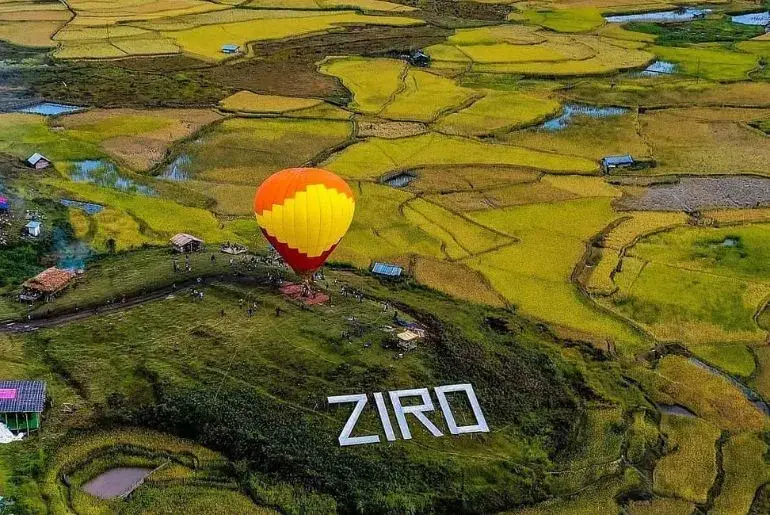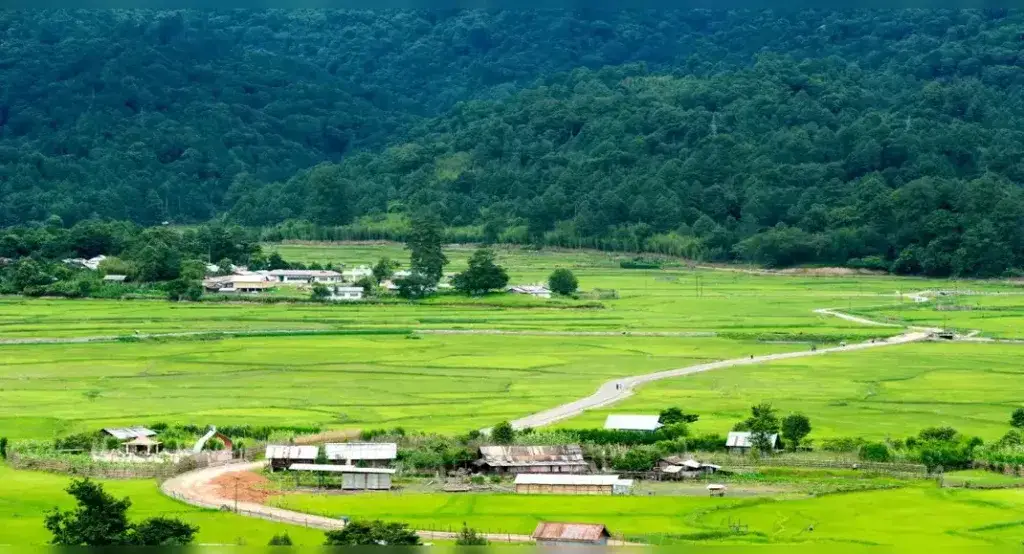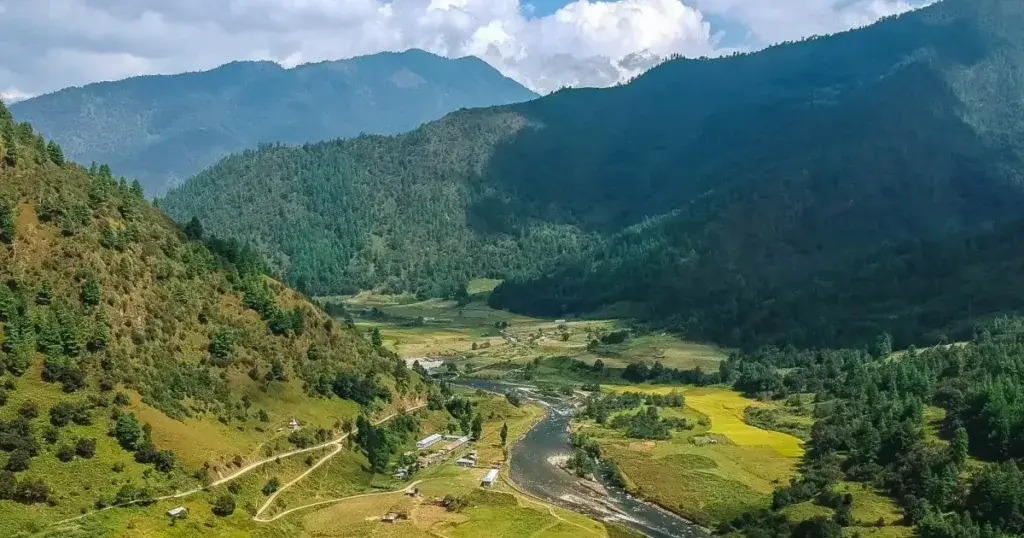Introduction
Many places in India are famous worldwide for their natural beauty. India’s northeastern areas rank among the top travel destinations. The beautiful valleys, lush green forests, flowing waterfalls, and high mountains of Arunachal Pradesh fascinate everyone, you can go to Ziro Valley of Arunachal Pradesh with your friends for a bachelor trip. This place is no less than a paradise for all the tourists, especially the youth.

This place is good and safe, girls can go here alone or on a girl trip. Many people might know that Arunachal Pradesh is the only state in India where sunrise occurs first. You can lose yourself in the breathtaking natural splendor of Ziro Valley. So let us know about the best destination in Arunachal Pradesh, Zero Valley.
History of ziro
It is a small but vibrant town in Arunachal Pradesh and is also known for its rich tribal culture, stunning natural scenery, and relaxing atmosphere. Its history spans several centuries and includes many journeys from prehistoric trade routes to post-independence development.
Early History: The name Ziro is believed to come from “void” or “space” in the tribal language Appatani. The Appatani tribe has inhabited the area for centuries, becoming skilled farmers and craftsmen in the process. Their rich cultural heritage – including body painting and headhunting – remains an important part of their tradition.
Trade Routes: Ziro had strategic importance due to its location on ancient trade routes. Important trade routes between Tibet and Assam passed through this place which promoted trade and cultural exchange.
Colonial period: During British colonial rule, Ziro developed as an administrative center. In 1912, it was made the headquarters of Dibang Valley. However, colonial influence also influenced local culture and traditions.
Post-Independence: After India’s independence, Ziro gradually began to develop as a modern city. As government offices, educational institutions, and the tourism industry grew, so did its economic activity. However the locals have still worked hard to protect their cultural legacy, and Ziro is still a thriving hub for tribal customs today.
Places to visit in Ziro Valley
Tarin Fish Farm
Zero Valley is situated at a very high altitude, yet fish farming is done here, flowers are cultivated in Ziro Valley and some very rare species of orchids are cultivated here. This place is very beautiful.
Talley Valley Wildlife Sanctuary
You can reach this Tally Valley Wildlife Sanctuary just 32 km from Zero Valley. Tally at an altitude of 2400 meters is a dense forest of silver colored deodar, with tall and huge deodar trees on both sides. Blessed with lush green views, dense forests of ferns, bamboo, orchids, silver fir, and rhododendrons surround this century.


Ziro valley
Ziro Valley is one of the most beautiful valleys of Arunachal Pradesh. A beautiful place for those who like to take photographs and spend time with nature. The Shiva Lingam in Kardo Hills, Tally Valley, Kardo Hills Wildlife Sanctuary, and Tally Valley are some of the area’s other main draws. worth seeing.
Locks valley
Tale Valley, which is around 32 km northeast of this place, is especially famous for its wildlife. There are many such places here, which will give you peace of mind. This valley is worth visiting because of its beauty. Ziro Valley is very good for trekking lovers.
Ziro son
By coming to this place with your eyes open, your body and mind will also become happy. It is fun to sit comfortably in the greenery spread everywhere, but do not forget to capture the views here on camera. Zero Son is also known as Army Putu. Because the Army Cantonment was built here in 1960.
Meghna Cave Temple
Meghna Cave Temple is dedicated to Lord Shiva and is located very close to this place. To have the darshan of Lord Shiva here, you will have to climb a lot of stairs, which may take about ten minutes. After seeing this five-thousand-year-old temple, all your fatigue will go away.
Apart from this, Bomdila-Seppa, Along-Machuka, Daporijo-Taksing, Pasighat-Tuting, Pasighat-Mariang, and Bomdila-Dayamara tracks via Ramalingam and Chauk are also very popular.
A river rafting facility is also available here for adventure lovers. You can enjoy rafting in the Siang River whose path passes through Kameng, Subansiri, and Dibang rivers.
Women of the Apatani tribe
When coming here you will see that Apatani women get a tattoo which consists of blue stripes which are wide in size and extend from the head to the tip of the nose and five vertical lines are drawn below the lower lip on the chin. The hair is arranged neatly on the top of the head in a bun called a parting.

Traditional villages of Ziro Valley
There is no doubt that the Apatani tribal villages of Ziro, Arunachal Pradesh are some of the most charming in the entire region. Although many Apatans have converted to Christianity, some families still practice Animism or Donyi-Polo (which translates to Sun-Moon), proudly bearing the Donyi-Polo flag in their homes.
Tago took us on a tour of the tribal villages of the Ziro Valley, starting with the village where we were staying – Hari Village. There we learned all about the importance of nago (a shed with a monkey skull inside) and babo. /span> has special significance as it is the only village built only of wood, without the use of cement, and is being protected by UNESCO. In Hong Village it is called Lapanglapang. (a wooden pole used during festivals), as well as the traditional performance stage called
We were shown altars near many tribal houses on which animals are sacrificed. Fresh blood was shown on some altars indicating a recent sacrifice. Eggs play an important role in sacrificial rituals and egg shells and feathers decorate many altars. Tago also explained that a feathered stick placed in front of the door of the house indicates that a ritual is taking place inside the house, and the family should not be disturbed.
This experience reminded us a lot of the culture and customs we saw in West Timor. Some tribal villages in Sumba, Indonesia, and Laos, where similar animist beliefs are still held and practiced.
The Apatani tribe has no written history and relies on narratives and stories passed down from one generation to the next. For this reason, they are aware of the existence of past enemies and tribal wars but are not entirely sure about who, when, and where.
We would have visited seven villages in total, including the one where we stayed – Hari, Bula, Datta, Hija, Bami Michi, Mudan Tage, and Hong (the largest of all the seven). We passed through gorgeous rice fields (the walk from Datta to Hija was particularly spectacular), experienced some fantastic hospitality, and observed all sorts of animist practices (including a ritual performed by a shaman).
Our tour of seven tribal villages was easily one of the most interesting and enlightening during our Arunachal Pradesh travel experiences, tribal villages are one of the best places to visit in Ziro!
Local market in Hapoli
You don’t need a guide to visit the Apatani market in Hapoli, just make sure you’re ready for a visual ‘adventure’. In addition to a wide range of fruits and vegetables, meat, and fish, items for sale also include dead rats and wasp larvae! This is easily one of the most colorful places to visit in Ziro, but consider yourself forewarned!
Eggs in Ziro Valley and Eggs Garden in Ziro Valley
This is one of the most unique places to visit in Ziro, Arunachal Pradesh! You may be wondering what an egg garden could be. The Egg Garden located a few hundred meters east of Hong Village, includes an area containing a series of altars made of bamboo eggshells and feathers.
This is where the local people of Hong Village usually come to perform animistic rituals and sacrifices for favorable outcomes in critical situations. Chickens were often sacrificed, and fresh blood was evident around some altars. To find the Egg Garden, head east from Hong Village along a path with bamboo plantations on either side. The egg garden will be on your right.
Visit the local animist cemeteries of Ziro Valley
Tago showed us the animist cemeteries located behind various villages. Complex burial structures were built for magicians, while simpler ones were meant to bury more common people. He explained that during animist burials, animals (such as cows and ibex) are sacrificed, and the animals’ horns are placed at the burial site. This practice can be quite expensive for ordinary villagers, a concept that taunts us in Toraja and Sumba, Indonesia.
Local banana tree deity in Hija village (Dora Kullu)
Legend has it that a man named Dora Marpu once saw a wild banana tree growing from the roof of his hut and threw it into the pig pen below his stilt house. The banana plant (which does not grow anywhere else in Ziro), spread to the surrounding area, and at the same time, fungus developed on the skin of village children, apparently killing some. The villagers attributed this incident to the power of the banana tree, which eventually came to be worshiped as a deity.
District Museum at Hapoli
The museum displays artifacts of various tribes of Arunachal Pradesh. Once we got past the dusty cases and messy interior we found the whole setup quite interesting.
The museum contains several maps showing the features of different districts of Arunachal which are informative, making it one of the more interesting places to visit in Ziro if you want to learn about the tribes of Arunachal Pradesh. Come for a few minutes but you’ll probably want to stay a little longer, though you should know that the museum is in desperate need of some care!
Note that while looking for things to do in Ziro Valley, we read a few articles that mentioned a visit to the Meghna Cave Temple. As mentioned, this temple is not located in the ‘city of Ziro’ but closer to Daporizo, another town located about 6 to 8 hours away from Ziro.
Where is Ziro Valley and why should you visit?
Like all other places in Arunachal Pradesh, travel infrastructure is quite challenging, and reaching Ziro, Arunachal Pradesh is inconvenient (though by no means up to Tawangya Aalo). Ziro Valley is not a destination for luxury travelers, rather it is a nature-lovers paradise, and a place of great interest for those wishing to learn more about the tribes of Arunachal Pradesh.
It is located about 115 km from Itanagar, the capital of Arunachal Pradesh in northeastern India. The area is full of hills, pine forests, and rice fields, and its climate is relatively mild (although it can get quite cold at night!).
It is important to understand that this place is home to the two towns of Hapoli (New Ziro) and Old Ziro and several traditional villages. Although it is entirely possible to wander around and visit each village on foot, given their proximity, it is advisable to have a bike or car if you are on a busy schedule and want to visit them all in a single day. She goes.
It is not as popular a place as Tawang (take ‘popular’ with a pinch of salt here, the northeast is extremely unexplored), and the area is incredibly peaceful, dreamy, and green, dotted with villages with characteristic bamboo houses. Apatani tribe. There are some resorts and hotels in Ziro, Arunachal Pradesh, but we believe homestays are a better source of accommodation. More on that later.
If you want to experience harmony and natural beauty in a calm and serene environment where time seems to stand still, then Ziro, Arunachal Pradesh should be included in your Northeast India itinerary, but you should know that Arunachal Pradesh is Not an easy field. In which one can travel freely.
Remember that foreigners require a Protected Area Permit (PAP) to travel to Arunachal Pradesh while Indian citizens require an Inner Line Permit (ILP). If you don’t have much time, we recommend you use the services of a travel agency like Holiday Scout for a complete travel experience. Area. Even if you choose to travel independently like us, Holiday Scout can provide you with services like helping you get a PAP, and locating recommending, and booking itineraries. Accommodation for you.
Best season to visit Ziro Valley
Although the weather of Ziro Valley is perfect to visit throughout the year, you can plan here from summer to monsoon and winter. But the season from October to April is considered the best. From December to January the valley experiences extreme cold.
Ziro Valley sees large numbers of tourists during the Ziro Music Festival, held each year for four days (usually in September), although we heard rumors that the festival might be canceled due to damage caused to the local football field during the event. Is. If you want to experience the festivities, this would be the best time to visit Ziro Valley!
If you are not interested in attending the Ziro Music Festival, October and November are better months to visit Ziro Valley, as it starts getting quite cold in December. During our trip in early November, we needed to wear thick clothes at night, although during the day we wore T-shirts!
In summer: From April to June the temperature here remains between 6 to 20 degrees, in which you can enjoy roaming here in normal clothes.
In monsoon: The temperature here remains between 2 to 19 degrees during monsoon, but on the way to reach Ziro Valley, one may have to face floods at many places, due to which one should avoid traveling during this period.
In Winter: You can also plan to explore this beautiful place between October to March. Light woolen clothes will do.
important information
The most important thing to keep in mind before going on a trip is that due to it being a restricted area, domestic tourists are required to take an Inner Line Permit to visit Arunachal Pradesh, while foreign tourists have to take a Protected Area Pass. All this can be obtained from the office of the Resident Commissioner, which is located in Delhi, Kolkata, Guwahati.
Hotels and other types of accommodation in Ziro
Although there are a few resorts and hotels in Ziro, we recommend homestays over any other type of accommodation. The homestay is located in the heart of Hari village, one of the traditional Apatani tribe villages of Ziro.
Our spacious room in an equally spacious house was like a luxury suite, which is rare in Northeast India. We ate our breakfast and dinner in the common area beside the traditional fireplace, where the family gathered every evening to warm up and exchange stories of the day.
The owner, Mr. Hej Dollo, is an ambitious man who will answer all your questions about the Ziro Valley and the Apatani tribe, their customs, and traditions. After dinner, we were treated to whiskey and barbecued frogs as he explained all about the hunting practices of the Apatani tribe, and also showed us his collection of trophies from previous hunts.
It was one of the best rooms we had during our stay in Arunachal Pradesh, and the food cooked by the lovely Mrs. Dollo was delicious, but we felt that the most important aspect of staying in this type of accommodation was the knowledge provided.
The cost of staying here is usually Rs 1200 (about €14.75) per person, which includes breakfast and dinner.
How to reach?
By Road: Night buses run from Guwahati to Ziro. Arunachal Pradesh State Road Transport Corporation buses run four days a week. However, after reaching North Lakhimpur or Itanagar, you can take a taxi from here to reach Zero Valley.
Air Travel: Jorhat in Assam is the nearest airport, with many domestic flights. From there one can reach Ziro Valley by bus or train.
Train Travel: Those wishing to travel by train can reach North Lakhimpur Railway Station in Assam, from where taxis and buses reach Ziro Valley in 4-5 hours.
Conclusion:
Ziro Valley is hidden in the center of Arunachal Pradesh, where culture and nature come together to amaze and calm the spirit. Nestled between dark mountains, and deep forests, with lush green fields, ziro valley is a gem of natural beauty. But its beauty not only attracts the eyes but also drenches the rich traditions of the Apatani tribe.
The women here are not only the backbone of the family but also do farming work very well. The tattoos printed on their faces and tied around their heads sing of their unique culture. The clear water of the Pakka River flowing between the villages is a sign of their mutual goodwill and sensitivity towards the environment. People dancing and singing to the beat of drums every evening testify to the vibrant culture of Ziro.
Ziro is not just a place to visit, it is an experience. Sitting here in the lap of the mountains and watching the sunrise, talking to women working in the fields, tasting local cuisine, watching tribal dances, and strolling along the banks of the river Pakke, are experiences that last a lifetime. This valley gives you a chance to connect with yourself and the beauty of nature, away from the noisy world.
Also, read some of our fascinating Post :
- Kasol: Beyond the Buzz – A Paradise for Seekers and Wanderers
- Cherrapunji: Conquer the Clouds while Trekking Through the Enchanting beauty
- The World’s Longest River Dam on Earth – The Massive Hirakud Dam, India.
- Rann of Kutch: Breathtaking Canvas of Salt and Sky
- Meghalaya Tourism: A Paradise in Northeast india.
- Hampi: The Lost City of Vijayanagara in Karnataka
- Pushkar – Spiritual & Cultural Journey in Heart of Rajasthan
- Mahabaleshwar: A Guide to the Best Tourist Hill Station of Maharashtra.
- Experiencing the Coastal Charms of Alibaug, Maharashtra
- Matheran: The Hill Station Where Time Stands Still.
#indiansites
